- Home
- Philip K. Dick
The Shifting Realities of PK Dick Page 3
The Shifting Realities of PK Dick Read online
Page 3
Again, the point here is not to seek to argue on behalf of Dick as an inspired seer, or even—necessarily—as a “sane” human being. (There is no proof possible as to the sanity or insanity of Philip K. Dick.)7 Rather, it is to challenge the reader to resist labels and to plunge into the ideas expressed in the texts themselves, and to wrest from them what seems useful and vital without regard to predisposing diagnostic labels. One might further urge that readers suspend their tendency to read Dick’s metaphysical writings with belief or disbelief foremost in mind. For Dick, as the writings themselves reveal, had no pointedly persuasive intentions with respect to the reader. In turn, those readers who refuse to worry over whether Dick persuades them on any particular points may find that he illumines any number of prospective paths for further exploration. There is a beauty and a visionary intensity to the possibilities Dick offers, as in “Cosmogony and Cosmology,” a 1978 essay in which Dick sought to distill key concepts of the Exegesis. The divine form discussed is that of a righteous Godhead (akin to the redeeming Logos of the Gnostics) who has lost the memory of himself as the true creator and has ceded control of the earthly realm to a blind and ignorant demiurge or “artifact.” This “artifact” (akin to the Gnostic Archon) holds all humans in its delusional thrall, and even the Godhead must struggle against it.8
Observe how Dick, in tracing out the possibilities of this spiritual viewpoint, employs the narrative gifts of a fiction master to create a haunting parable of a fallen and amnesiac god who must wander for centuries through his own creations to win his own redemption:
He [the Creator] no longer knows why he has done all this to himself. He does not remember. He has allowed himself to become enslaved to his own artifact, deluded by it, coerced by it, finally killed by it. He, the living, is at the mercy of the mechanical. The servant has become the master, and the master the servant. And the master either renounced voluntarily his memory of how this happened and why, or else his memory was eradicated by the servant. Either way, he is the artifact’s victim.
But the artifact is teaching him, painfully, by degrees, over thousands of years, to remember—who he is and what he is. The servant-become-master is attempting to restore the master’s lost memories and hence his true identity.
One might speculate that he constructed the artifact—not to delude him—but to restore his memory. However, perhaps the artifact then revolted and did not do its job. It keeps him in ignorance.
The artifact must be fought; i.e., disobeyed. And then memory will return. It is a piece of the Godhead (Urgrund) which has somehow been captured by the artifact (the servant); it now holds that piece—or pieces—hostage. How cruel it is to them, these fragments of its legitimate master! When will it change?
When the pieces remember and are restored. First they must wake up and then they must return.
If all of this seems impossibly speculative to the reader, it may be still more unsettling to realize that there is a direct parallel between the ideas expressed by Dick above and the cosmological theories posed by highly respected quantum physicists such as David Bohm. In The Holographic Universe, Michael Talbot offers a summary of Bohm’s viewpoint on the “implicate” and “explicate” orders of the cosmos that is strikingly analogous to the Urgrund/artifact dichotomy posed by Dick:
As we have seen, according to Bohm the apparent separateness of consciousness and matter is an illusion, an artifact that occurs only after both have unfolded into the explicate world of objects and sequential time. If there is no division between mind and matter in the implicate, the ground from which all things spring, then it is not unusual to expect that reality might still be shot through with traces of this deep connectivity. [Fellow physicist F. David] Peat believes that synchronicities are therefore “flaws” in the fabric of reality, momentary fissures that allow us a brief glimpse of the immense and unitary order underlying all of nature…. According to Peat, when we experience a synchronicity, what we are really experiencing “is the human mind operating, for a moment, in its true order and extending throughout society and nature, moving through orders of increasing subtlety, reaching past the source of mind and matter into creativity itself.”9
Dick was hardly an expert in quantum physics theories, though he did read in the field sporadically. As the essay “Drugs, Hallucinations, and the Quest for Reality” attests, he was especially interested in the concept of synchronicity posed by physicist Wolfgang Pauli (who worked in conjunction with C. G. Jung in formulating this theory). But the key parallels between Dick’s writings—both fiction and nonfiction—and the current insights of quantum physics do not seem, based on the evidence of the Exegesis and other personal writings by Dick, to have been based on reading, but rather on an experiential grappling on Dick’s part that proved synchronous, as it were, with the findings of the quantum physicists. For example, in his 1977 speech “If You Find This World Bad, You Should See Some of the Others,” included herein—a speech that predates any widespread public discussion of the quantum physics notion that the known structure of the cosmos may aptly be described by the metaphor of a hologram—we find Dick asking, based on his experiences of 2-3-74, “Do we collectively dwell in a kind of laser hologram, real creatures in a manufactured quasi-world, a stage set within whose artifacts and creatures a mind moves that is determined to remain unknown?”
Nor is quantum physics the only field in which Dick’s speculations find a revelatory context. Consider the concept of “fake fakes,” which is put to use in so many of Dick’s novels and stories and which is explored persistently in his nonfiction writings as well. Examples included in the present volume may be found in the outline for a proposed (but never completed) novel Joe Protagoras Is Alive and Living on Earth, as well as in the proposal for a script (never written) for the television series Mission: Impossible and in the 1978 speech (likely never delivered) “How to Build a Universe That Doesn’t Fall Apart Two Days Later.” In essence, a “fake fake” is—despite its seeming status as a mere contradiction that equates into “genuine”—a radically new ontological category that takes on significance precisely because it perplexingly mimics (and even threatens to supersede) our “ordinary” or consensual reality. Hence the “fake fake” is no mere SF plot prop—although Dick certainly employed it to dazzling effect as just such a prop—but is also a commentary on the inundation of our world by mechanical and computer-generated simulacra.
In the field of art, Marcel Duchamp explored a similar range of ideas with his concept of the “readymade,” a found object that Duchamp would ironically designate as a work of art, at times adding his own visual or linguistic touches (in which case the object became a “readymade aided”). In his 1961 essay “Apropos of ‘Readymades,’” Duchamp broached paradoxes that serve to elucidate certain aesthetic possibilities of a world in which Dickian “fake fakes” proliferate. Wrote Duchamp:
At another time wanting to expose the basic antimony between art and readymades I imagined a “reciprocal readymade”: use a Rembrandt as an ironing board!…
Another aspect of the “readymade” is its lack of uniqueness … the replica of a “readymade” delivering the same message; in fact nearly every one of the “readymades” existing today is not an original in the conventional sense.
A final remark to this egomaniac’s discourse. Since the tubes of paint used by the artist are manufactured and readymade products we must conclude that all the paintings in the world are “readymades aided” and also works of assemblage.10
The “fake fake” of Dick and the “readymade” (and its permutations) of Duchamp are, at root, cognate ideas expressing the shimmering indeterminacy between originals and simulacra that is the hallmark of the virtual reality—both as metaphor and as technology—of postindustrial society. It was Walter Benjamin, in his seminal 1936 essay “The Work of Art in the Age of Mechanical Reproduction,” who first clearly delineated this tension. But it was Philip K. Dick, in numerous works including the pointedly titled The Simulacra (1964), who first crea
ted a body of fiction that brought the tension to life. The concept of the “simulacrum” has since become a staple of postmodernist criticism—thus the praise offered by Baudrillard of Dick’s works as “a total simulation without origin, past or future.”
A brief note on the principles of selection of writings included in the present volume: The primary goal was to set forth the best of Dick’s nonfictional efforts. But there was also the secondary aim of offering a representative sampling of his different nonfictional modes—autobiographical; informal free flights of ideas (in the cozy obscurity of SF fanzines); critical examinations of the SF genre and of his own works in particular; and extended philosophical and theological analyses. In writing of his own life, Dick could range from brutal honesty to blatant fabulistic enhancements. No effort has been made in this volume to sort out “truth” from “fiction” in his autobiographical accounts. (Readers interested in one effort to do so may consult my Divine Invasions: A Life of Philip K. Dick.)
There are, in addition, selections herein from Dick’s fiction: (1) two brief excerpts from an early unpublished Dick mainstream novel—Gather Yourselves Together (written in 1949)—featuring autobiographical elements bearing on Dick’s experience of reality; and (2) the two completed chapters of the proposed sequel to The Man in the High Castle—tentatively titled, at one point, as To Scare the Dead—which have long deserved publication, and, in addition, benefit from being read in conjunction with “Naziism and the High Castle” and “Biographical Material on Hawthorne Abendsen.”
For all selections, the year cited with the title is the year of first publication; or, if the piece is unpublished, the year in which it was written (in the case of the Exegesis, the year provided represents, in some cases, my best estimate based on internal textual clues); or if the piece was published significantly later than the writing thereof, the year it was written followed by the year of publication.
At his best, as evidenced both by his fiction and by his finest metaphysical speculations, Dick joins the great creators of parable and paradox of this century—a lineage that includes G. K. Chesterton, Franz Kafka, Rene Daumal, Jorge Luis Borges, Samuel Beckett, Flann O’Brien, and Italo Calvino.
Note to the Vintage edition: Two inadvertent errors in the dating of “The Two Completed Chapters of a Proposed Sequel to The Man in the High Castle” and the Exegesis entry on page 328 have been corrected in this paperback edition.
Part One
Autobiographical Writings
THE writings in this section have been grouped together by the fact that their content focuses exclusively or primarily on Dick’s life. It will be obvious to the reader, however, that many of the writings included in other sections of this volume contain autobiographical elements as well. In his writings, Dick frequently drew upon events in his life to elucidate his ideas, and, in like manner, drew upon the ideas that most fascinated him at any given time to elucidate past events.
The two selections from the mainstream novel Gather Yourselves Together (1949) vividly portray the psyche of the young and innocent protagonist Carl, who bears a close resemblance to the young Philip K. Dick. These are certainly not autobiographical passages, but they nonetheless offer insight into the modes of thought and feeling of the apprentice writer coming of age. This novel was published in a limited edition by WCS Books in 1994.
“Introducing the Author” was first published (with an accompanying photograph of Dick) on the inside front cover of Imagination: Stories of Science and Fantasy (February 1953).
“Biographical Material on Philip K. Dick” (1968) was apparently prepared for the use of one of Dick’s publishers. It is published here for the first time.
“Self Portrait” was first published, according to Paul Williams, “in mid- or late 1968 for a Danish magazine or fanzine edited by Jannick Storm.” It first appeared in English in the Philip K. Dick Society (PKDS) Newsletter (edited by Williams), No. 2, December 1983.
“Notes Made Late at Night by a Weary SF Writer,” written in 1968, was first published in Eternity Science Fiction, Old Series, No. 1, July 1972. It was reprinted in the PKDS Newsletter, Nos. 22-23, December 1989.
The two autobiographical sketches—each titled “Biographical Material on Philip K. Dick” and written in 1972 and 1973, respectively—are published here for the first time.
“Memories Found in a Bill from a Small Animal Vet” first appeared in The Real World, No. 5, February-March 1976.
“The Short, Happy Life of a Science Fiction Writer” first appeared in Scintillation, Vol. 3, No. 3, June 1976.
“Strange Memories of Death,” written in 1979, first appeared in Interzone, Summer 1984, and was republished in the Dick essay-story collection I Hope I Shall Arrive Soon, edited by Mark Hurst and Paul Williams.
The 1980 epistolatory exchange with critic Frank Bertrand—titled (in Dick’s typed transcript) “Philip K. Dick on Philosophy: A Brief Interview”—was first published in Niekas, No. 36, in 1988. The version published here comes from the typed transcript in the possession of the Dick Estate.
Two Fragments from the Mainstream Novel Gather Yourselves Together (1949)
THIS was what happened to all the things that came out of the wet earth, out of the filthy slime and mold. All things that lived, big and little. They appeared, struggling out of the sticky wetness. And then, after a time, they died.
Carl looked up at the day again, at the sunlight and the hills. It did not look the same, now, as it had looked a few moments before. Perhaps he saw it more clearly than he had a moment ago. The sky, blue and pure, stretched out as far as the eye could see. But blood and feathers came from the sky. The sky was beautiful when he stood a long way off from it. But when he saw too closely, it was not pretty. It was ugly and bitter.
The sky was held together with tacks and gum and sticky tape. It cracked and was mended, cracked and was mended again. It crumbled and sagged, rotted and swayed in the wind, and like the sky in the children’s story, part of it fell to earth.
Carl walked on slowly. He stepped off the road and climbed a narrow dirt ridge. Soon he was going up the side of a grassy slope, breathing deeply and taking big steps. He stopped for a moment, turning to look back.
Already the Company and its property had become small, down below him. Shrunk, dwindling away. Carl sat down on a rock. The world was quiet and still around him. Nothing stirred. His world. His silent, personal world.
But he did not understand it. So how could it be his world? He had come out to smile at the flowers and grass. But he had found something more, something that he could not smile at. Something that was not pleasant at all. Something that he did not like nor understand nor want.
So it was not his world. If it were his world he would have made it differently. It had been put together wrong. Very much wrong. Put together in ways that he could not approve of.
The silent bird, lying in the road. It reminded him of something. His thoughts wandered. What did it remind him of? A strange feeling drifted through him. This had happened before. This very thing. He had gone out and found something terrible. Something that did not make sense. Something he could not explain or understand.
After a while he remembered. The cat. The dying old cat, with its broken ears, one eye gone, its body thin and dry with patches of loose hair. The cat and the bird. Other things. Flies buzzing around. Streams of ants. Things dying, disappearing silently, drifting away. With no one to watch or care.
He had never understood it, this thing that he found, in the great warm world. It had no meaning. No sense. Was there some purpose? Some reason?
When he understood the cat was dead he had gone back inside the house, walking slowly, deep in thought. Back inside, to his room, his things. His microscope. His stamps and maps and drawings and books. They had meaning. Purpose. Their existence had reason to it. He could look at them and understand them.
Carl sat on the hillside, thinking about his childhood. It was not so long ago. Not so very many years in the
past. He could feel the memories rising up around him, seeping up on all sides of him. Sights, smells. Tastes. His past was very much with him. It was close, just below the surface. Waiting to come up. His room. His microscope. The drawings he had made.
He sat and remembered about them.
* * * *
Her breasts amazed him. They did not jut out and up. They did not swell, pressing forward as the drawings had shown them. They hung down, and when she bent over they fell away from her. They bounced and swung when she picked up her clothes, bending over and reaching down to dress. They were not hard cups at all, but flesh like the rest of her, soft pale flesh. Like wineskins hanging on tent walls in Middle East villages. Sacks, wobbling flesh sacks that much [sic; must] have got in her way every now and then.
She buttoned her short red pants and fastened her gray blouse around her. She sat down to tie her sandals. Now she looked the same as she always had, not white, bare, chunky. Her breasts were again curves under her blouse, not bulging wineskins hanging down. In the close-fitting pants and blouse she looked taller and slimmer.
She finished dressing and went off, across the lawn. He lost sight of her. She had disappeared. It was finished. He relaxed. His blood subsided. His heart began to return to normal, the color draining out of his cheeks and ears. He sighed, letting out his breath.
Had it really happened? He felt dazed. In a way he was disappointed. She had been white and short, bulging here and there. With legs for walking and feet for standing. Her body was like all bodies, a physical creation, an instrument, a machine. It had come into the world the same way as other things, from the dust and wet slime. After a while it would wither and sag and crack and bend, and the tape and glue and tacks would give way to let it sink back down into the ground again, from which it had come.
It would break and wear out. It would fade and pass away, like the grass and the flowers, the great fir trees above him, like the hills and the earth itself. It was a part of the ordinary world, a material thing like other material things. Subject to the same laws. Acting in the same way.
Observe how Dick, in tracing out the possibilities of this spiritual viewpoint, employs the narrative gifts of a fiction master to create a haunting parable of a fallen and amnesiac god who must wander for centuries through his own creations to win his own redemption:
He [the Creator] no longer knows why he has done all this to himself. He does not remember. He has allowed himself to become enslaved to his own artifact, deluded by it, coerced by it, finally killed by it. He, the living, is at the mercy of the mechanical. The servant has become the master, and the master the servant. And the master either renounced voluntarily his memory of how this happened and why, or else his memory was eradicated by the servant. Either way, he is the artifact’s victim.
But the artifact is teaching him, painfully, by degrees, over thousands of years, to remember—who he is and what he is. The servant-become-master is attempting to restore the master’s lost memories and hence his true identity.
One might speculate that he constructed the artifact—not to delude him—but to restore his memory. However, perhaps the artifact then revolted and did not do its job. It keeps him in ignorance.
The artifact must be fought; i.e., disobeyed. And then memory will return. It is a piece of the Godhead (Urgrund) which has somehow been captured by the artifact (the servant); it now holds that piece—or pieces—hostage. How cruel it is to them, these fragments of its legitimate master! When will it change?
When the pieces remember and are restored. First they must wake up and then they must return.
If all of this seems impossibly speculative to the reader, it may be still more unsettling to realize that there is a direct parallel between the ideas expressed by Dick above and the cosmological theories posed by highly respected quantum physicists such as David Bohm. In The Holographic Universe, Michael Talbot offers a summary of Bohm’s viewpoint on the “implicate” and “explicate” orders of the cosmos that is strikingly analogous to the Urgrund/artifact dichotomy posed by Dick:
As we have seen, according to Bohm the apparent separateness of consciousness and matter is an illusion, an artifact that occurs only after both have unfolded into the explicate world of objects and sequential time. If there is no division between mind and matter in the implicate, the ground from which all things spring, then it is not unusual to expect that reality might still be shot through with traces of this deep connectivity. [Fellow physicist F. David] Peat believes that synchronicities are therefore “flaws” in the fabric of reality, momentary fissures that allow us a brief glimpse of the immense and unitary order underlying all of nature…. According to Peat, when we experience a synchronicity, what we are really experiencing “is the human mind operating, for a moment, in its true order and extending throughout society and nature, moving through orders of increasing subtlety, reaching past the source of mind and matter into creativity itself.”9
Dick was hardly an expert in quantum physics theories, though he did read in the field sporadically. As the essay “Drugs, Hallucinations, and the Quest for Reality” attests, he was especially interested in the concept of synchronicity posed by physicist Wolfgang Pauli (who worked in conjunction with C. G. Jung in formulating this theory). But the key parallels between Dick’s writings—both fiction and nonfiction—and the current insights of quantum physics do not seem, based on the evidence of the Exegesis and other personal writings by Dick, to have been based on reading, but rather on an experiential grappling on Dick’s part that proved synchronous, as it were, with the findings of the quantum physicists. For example, in his 1977 speech “If You Find This World Bad, You Should See Some of the Others,” included herein—a speech that predates any widespread public discussion of the quantum physics notion that the known structure of the cosmos may aptly be described by the metaphor of a hologram—we find Dick asking, based on his experiences of 2-3-74, “Do we collectively dwell in a kind of laser hologram, real creatures in a manufactured quasi-world, a stage set within whose artifacts and creatures a mind moves that is determined to remain unknown?”
Nor is quantum physics the only field in which Dick’s speculations find a revelatory context. Consider the concept of “fake fakes,” which is put to use in so many of Dick’s novels and stories and which is explored persistently in his nonfiction writings as well. Examples included in the present volume may be found in the outline for a proposed (but never completed) novel Joe Protagoras Is Alive and Living on Earth, as well as in the proposal for a script (never written) for the television series Mission: Impossible and in the 1978 speech (likely never delivered) “How to Build a Universe That Doesn’t Fall Apart Two Days Later.” In essence, a “fake fake” is—despite its seeming status as a mere contradiction that equates into “genuine”—a radically new ontological category that takes on significance precisely because it perplexingly mimics (and even threatens to supersede) our “ordinary” or consensual reality. Hence the “fake fake” is no mere SF plot prop—although Dick certainly employed it to dazzling effect as just such a prop—but is also a commentary on the inundation of our world by mechanical and computer-generated simulacra.
In the field of art, Marcel Duchamp explored a similar range of ideas with his concept of the “readymade,” a found object that Duchamp would ironically designate as a work of art, at times adding his own visual or linguistic touches (in which case the object became a “readymade aided”). In his 1961 essay “Apropos of ‘Readymades,’” Duchamp broached paradoxes that serve to elucidate certain aesthetic possibilities of a world in which Dickian “fake fakes” proliferate. Wrote Duchamp:
At another time wanting to expose the basic antimony between art and readymades I imagined a “reciprocal readymade”: use a Rembrandt as an ironing board!…
Another aspect of the “readymade” is its lack of uniqueness … the replica of a “readymade” delivering the same message; in fact nearly every one of the “readymades” existing today is not an original in the conventional sense.
A final remark to this egomaniac’s discourse. Since the tubes of paint used by the artist are manufactured and readymade products we must conclude that all the paintings in the world are “readymades aided” and also works of assemblage.10
The “fake fake” of Dick and the “readymade” (and its permutations) of Duchamp are, at root, cognate ideas expressing the shimmering indeterminacy between originals and simulacra that is the hallmark of the virtual reality—both as metaphor and as technology—of postindustrial society. It was Walter Benjamin, in his seminal 1936 essay “The Work of Art in the Age of Mechanical Reproduction,” who first clearly delineated this tension. But it was Philip K. Dick, in numerous works including the pointedly titled The Simulacra (1964), who first crea
ted a body of fiction that brought the tension to life. The concept of the “simulacrum” has since become a staple of postmodernist criticism—thus the praise offered by Baudrillard of Dick’s works as “a total simulation without origin, past or future.”
A brief note on the principles of selection of writings included in the present volume: The primary goal was to set forth the best of Dick’s nonfictional efforts. But there was also the secondary aim of offering a representative sampling of his different nonfictional modes—autobiographical; informal free flights of ideas (in the cozy obscurity of SF fanzines); critical examinations of the SF genre and of his own works in particular; and extended philosophical and theological analyses. In writing of his own life, Dick could range from brutal honesty to blatant fabulistic enhancements. No effort has been made in this volume to sort out “truth” from “fiction” in his autobiographical accounts. (Readers interested in one effort to do so may consult my Divine Invasions: A Life of Philip K. Dick.)
There are, in addition, selections herein from Dick’s fiction: (1) two brief excerpts from an early unpublished Dick mainstream novel—Gather Yourselves Together (written in 1949)—featuring autobiographical elements bearing on Dick’s experience of reality; and (2) the two completed chapters of the proposed sequel to The Man in the High Castle—tentatively titled, at one point, as To Scare the Dead—which have long deserved publication, and, in addition, benefit from being read in conjunction with “Naziism and the High Castle” and “Biographical Material on Hawthorne Abendsen.”
For all selections, the year cited with the title is the year of first publication; or, if the piece is unpublished, the year in which it was written (in the case of the Exegesis, the year provided represents, in some cases, my best estimate based on internal textual clues); or if the piece was published significantly later than the writing thereof, the year it was written followed by the year of publication.
At his best, as evidenced both by his fiction and by his finest metaphysical speculations, Dick joins the great creators of parable and paradox of this century—a lineage that includes G. K. Chesterton, Franz Kafka, Rene Daumal, Jorge Luis Borges, Samuel Beckett, Flann O’Brien, and Italo Calvino.
Note to the Vintage edition: Two inadvertent errors in the dating of “The Two Completed Chapters of a Proposed Sequel to The Man in the High Castle” and the Exegesis entry on page 328 have been corrected in this paperback edition.
Part One
Autobiographical Writings
THE writings in this section have been grouped together by the fact that their content focuses exclusively or primarily on Dick’s life. It will be obvious to the reader, however, that many of the writings included in other sections of this volume contain autobiographical elements as well. In his writings, Dick frequently drew upon events in his life to elucidate his ideas, and, in like manner, drew upon the ideas that most fascinated him at any given time to elucidate past events.
The two selections from the mainstream novel Gather Yourselves Together (1949) vividly portray the psyche of the young and innocent protagonist Carl, who bears a close resemblance to the young Philip K. Dick. These are certainly not autobiographical passages, but they nonetheless offer insight into the modes of thought and feeling of the apprentice writer coming of age. This novel was published in a limited edition by WCS Books in 1994.
“Introducing the Author” was first published (with an accompanying photograph of Dick) on the inside front cover of Imagination: Stories of Science and Fantasy (February 1953).
“Biographical Material on Philip K. Dick” (1968) was apparently prepared for the use of one of Dick’s publishers. It is published here for the first time.
“Self Portrait” was first published, according to Paul Williams, “in mid- or late 1968 for a Danish magazine or fanzine edited by Jannick Storm.” It first appeared in English in the Philip K. Dick Society (PKDS) Newsletter (edited by Williams), No. 2, December 1983.
“Notes Made Late at Night by a Weary SF Writer,” written in 1968, was first published in Eternity Science Fiction, Old Series, No. 1, July 1972. It was reprinted in the PKDS Newsletter, Nos. 22-23, December 1989.
The two autobiographical sketches—each titled “Biographical Material on Philip K. Dick” and written in 1972 and 1973, respectively—are published here for the first time.
“Memories Found in a Bill from a Small Animal Vet” first appeared in The Real World, No. 5, February-March 1976.
“The Short, Happy Life of a Science Fiction Writer” first appeared in Scintillation, Vol. 3, No. 3, June 1976.
“Strange Memories of Death,” written in 1979, first appeared in Interzone, Summer 1984, and was republished in the Dick essay-story collection I Hope I Shall Arrive Soon, edited by Mark Hurst and Paul Williams.
The 1980 epistolatory exchange with critic Frank Bertrand—titled (in Dick’s typed transcript) “Philip K. Dick on Philosophy: A Brief Interview”—was first published in Niekas, No. 36, in 1988. The version published here comes from the typed transcript in the possession of the Dick Estate.
Two Fragments from the Mainstream Novel Gather Yourselves Together (1949)
THIS was what happened to all the things that came out of the wet earth, out of the filthy slime and mold. All things that lived, big and little. They appeared, struggling out of the sticky wetness. And then, after a time, they died.
Carl looked up at the day again, at the sunlight and the hills. It did not look the same, now, as it had looked a few moments before. Perhaps he saw it more clearly than he had a moment ago. The sky, blue and pure, stretched out as far as the eye could see. But blood and feathers came from the sky. The sky was beautiful when he stood a long way off from it. But when he saw too closely, it was not pretty. It was ugly and bitter.
The sky was held together with tacks and gum and sticky tape. It cracked and was mended, cracked and was mended again. It crumbled and sagged, rotted and swayed in the wind, and like the sky in the children’s story, part of it fell to earth.
Carl walked on slowly. He stepped off the road and climbed a narrow dirt ridge. Soon he was going up the side of a grassy slope, breathing deeply and taking big steps. He stopped for a moment, turning to look back.
Already the Company and its property had become small, down below him. Shrunk, dwindling away. Carl sat down on a rock. The world was quiet and still around him. Nothing stirred. His world. His silent, personal world.
But he did not understand it. So how could it be his world? He had come out to smile at the flowers and grass. But he had found something more, something that he could not smile at. Something that was not pleasant at all. Something that he did not like nor understand nor want.
So it was not his world. If it were his world he would have made it differently. It had been put together wrong. Very much wrong. Put together in ways that he could not approve of.
The silent bird, lying in the road. It reminded him of something. His thoughts wandered. What did it remind him of? A strange feeling drifted through him. This had happened before. This very thing. He had gone out and found something terrible. Something that did not make sense. Something he could not explain or understand.
After a while he remembered. The cat. The dying old cat, with its broken ears, one eye gone, its body thin and dry with patches of loose hair. The cat and the bird. Other things. Flies buzzing around. Streams of ants. Things dying, disappearing silently, drifting away. With no one to watch or care.
He had never understood it, this thing that he found, in the great warm world. It had no meaning. No sense. Was there some purpose? Some reason?
When he understood the cat was dead he had gone back inside the house, walking slowly, deep in thought. Back inside, to his room, his things. His microscope. His stamps and maps and drawings and books. They had meaning. Purpose. Their existence had reason to it. He could look at them and understand them.
Carl sat on the hillside, thinking about his childhood. It was not so long ago. Not so very many years in the
past. He could feel the memories rising up around him, seeping up on all sides of him. Sights, smells. Tastes. His past was very much with him. It was close, just below the surface. Waiting to come up. His room. His microscope. The drawings he had made.
He sat and remembered about them.
* * * *
Her breasts amazed him. They did not jut out and up. They did not swell, pressing forward as the drawings had shown them. They hung down, and when she bent over they fell away from her. They bounced and swung when she picked up her clothes, bending over and reaching down to dress. They were not hard cups at all, but flesh like the rest of her, soft pale flesh. Like wineskins hanging on tent walls in Middle East villages. Sacks, wobbling flesh sacks that much [sic; must] have got in her way every now and then.
She buttoned her short red pants and fastened her gray blouse around her. She sat down to tie her sandals. Now she looked the same as she always had, not white, bare, chunky. Her breasts were again curves under her blouse, not bulging wineskins hanging down. In the close-fitting pants and blouse she looked taller and slimmer.
She finished dressing and went off, across the lawn. He lost sight of her. She had disappeared. It was finished. He relaxed. His blood subsided. His heart began to return to normal, the color draining out of his cheeks and ears. He sighed, letting out his breath.
Had it really happened? He felt dazed. In a way he was disappointed. She had been white and short, bulging here and there. With legs for walking and feet for standing. Her body was like all bodies, a physical creation, an instrument, a machine. It had come into the world the same way as other things, from the dust and wet slime. After a while it would wither and sag and crack and bend, and the tape and glue and tacks would give way to let it sink back down into the ground again, from which it had come.
It would break and wear out. It would fade and pass away, like the grass and the flowers, the great fir trees above him, like the hills and the earth itself. It was a part of the ordinary world, a material thing like other material things. Subject to the same laws. Acting in the same way.

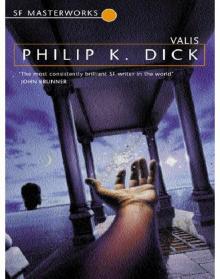 Valis
Valis The Simulacra
The Simulacra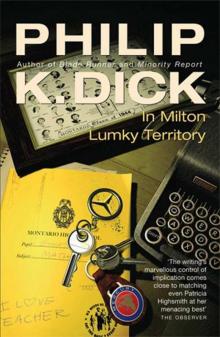 In Milton Lumky Territory
In Milton Lumky Territory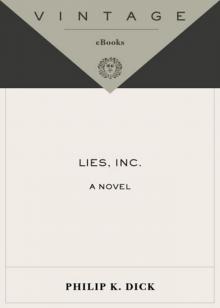 Lies, Inc.
Lies, Inc. The Man Who Japed
The Man Who Japed Selected Stories of Philip K. Dick
Selected Stories of Philip K. Dick Gather Yourselves Together
Gather Yourselves Together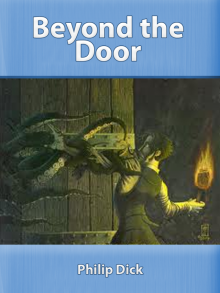 Beyond the Door
Beyond the Door Our Friends From Frolix 8
Our Friends From Frolix 8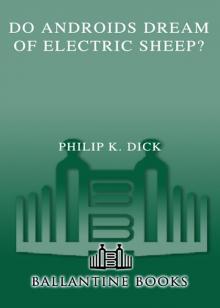 Do Androids Dream of Electric Sheep?
Do Androids Dream of Electric Sheep? The Short Happy Life of the Brown Oxford and Other Classic Stories
The Short Happy Life of the Brown Oxford and Other Classic Stories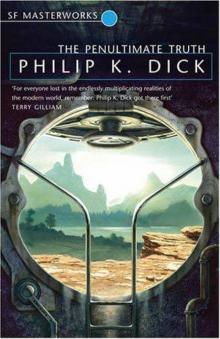 The Penultimate Truth
The Penultimate Truth Counter-Clock World
Counter-Clock World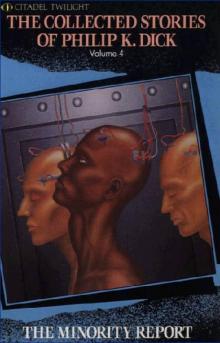 The Minority Report: 18 Classic Stories
The Minority Report: 18 Classic Stories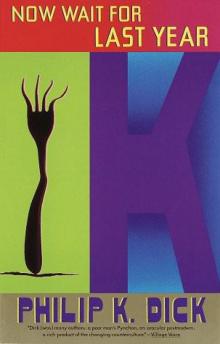 Now Wait for Last Year
Now Wait for Last Year The Broken Bubble
The Broken Bubble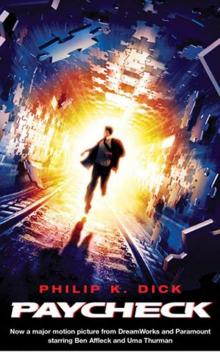 Paycheck
Paycheck Ubik
Ubik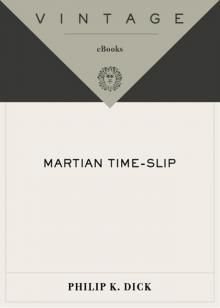 Martian Time-Slip
Martian Time-Slip The Shifting Realities of Philip K. Dick
The Shifting Realities of Philip K. Dick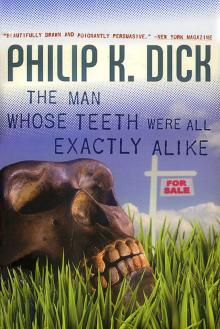 The Man Whose Teeth Were All Exactly Alike
The Man Whose Teeth Were All Exactly Alike Mary and the Giant
Mary and the Giant The Man in the High Castle
The Man in the High Castle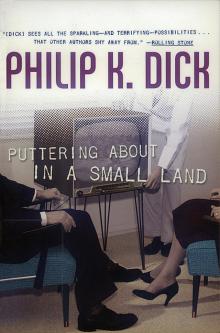 Puttering About in a Small Land
Puttering About in a Small Land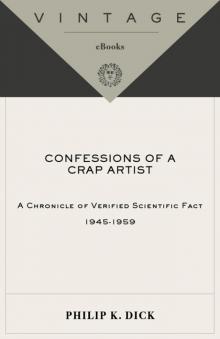 Confessions of a Crap Artist
Confessions of a Crap Artist Mr. Spaceship by Philip K. Dick, Science Fiction, Fantasy, Adventure
Mr. Spaceship by Philip K. Dick, Science Fiction, Fantasy, Adventure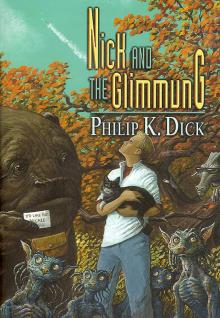 Nick and the Glimmung
Nick and the Glimmung Deus Irae
Deus Irae The Minority Report
The Minority Report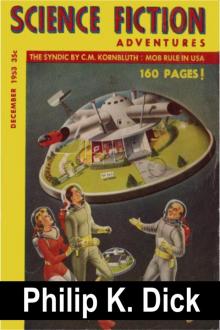 The Hanging Stranger
The Hanging Stranger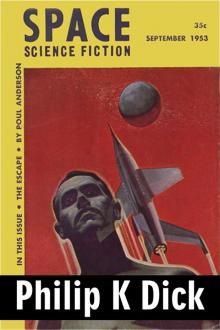 The Variable Man
The Variable Man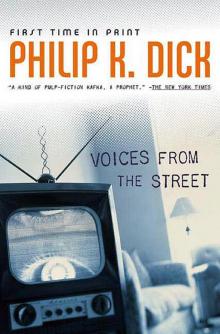 Voices From the Street
Voices From the Street Second Variety and Other Stories
Second Variety and Other Stories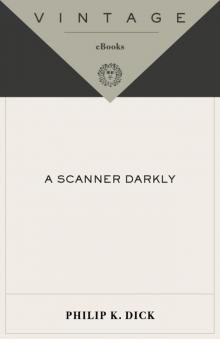 A Scanner Darkly
A Scanner Darkly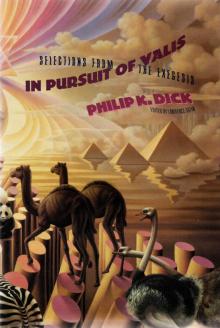 In Pursuit of Valis
In Pursuit of Valis The Three Stigmata of Palmer Eldritch
The Three Stigmata of Palmer Eldritch The Transmigration of Timothy Archer
The Transmigration of Timothy Archer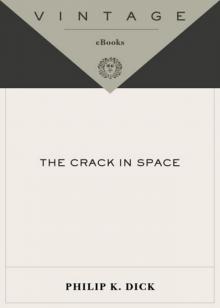 The Crack in Space
The Crack in Space The Collected Stories of Philip K. Dick 3: Second Variety
The Collected Stories of Philip K. Dick 3: Second Variety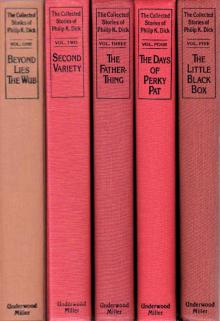 The Collected Stories of Philip K. Dick 4: The Minority Report
The Collected Stories of Philip K. Dick 4: The Minority Report The Skull
The Skull Solar Lottery
Solar Lottery Vulcan's Hammer
Vulcan's Hammer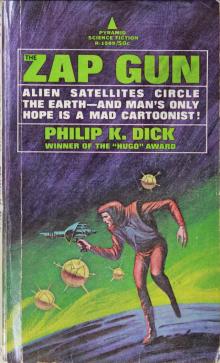 The Gun
The Gun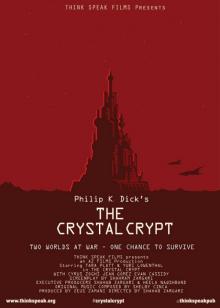 The Crystal Crypt
The Crystal Crypt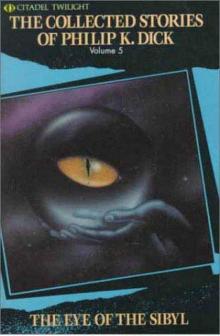 The Collected Stories of Philip K. Dick 5: The Eye of the Sibyl
The Collected Stories of Philip K. Dick 5: The Eye of the Sibyl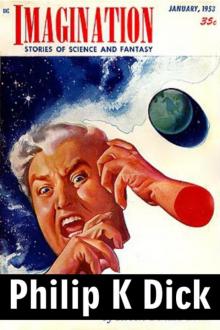 Mr. Spaceship
Mr. Spaceship The Zap Gun
The Zap Gun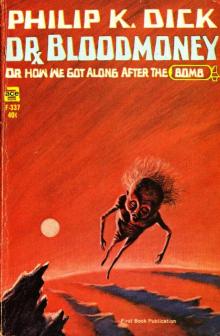 Dr. Bloodmoney
Dr. Bloodmoney Beyond Lies the Wub
Beyond Lies the Wub Galactic Pot-Healer
Galactic Pot-Healer The Divine Invasion
The Divine Invasion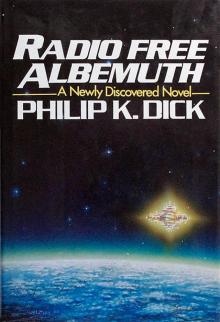 Radio Free Albemuth
Radio Free Albemuth A Maze of Death
A Maze of Death The Ganymede Takeover
The Ganymede Takeover The Philip K. Dick Reader
The Philip K. Dick Reader The Exegesis of Philip K. Dick
The Exegesis of Philip K. Dick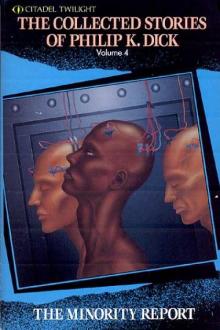 The Complete Stories of Philip K. Dick Vol. 4:
The Complete Stories of Philip K. Dick Vol. 4: Tony and the Beetles
Tony and the Beetles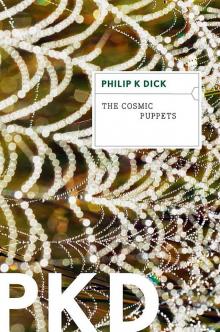 The Cosmic Puppets
The Cosmic Puppets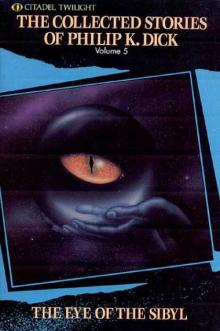 The Complete Stories of Philip K. Dick Vol. 5: The Eye of the Sibyl and Other Classic Stories
The Complete Stories of Philip K. Dick Vol. 5: The Eye of the Sibyl and Other Classic Stories Clans of the Alphane Moon
Clans of the Alphane Moon Flow My Tears, the Policeman Said
Flow My Tears, the Policeman Said The World Jones Made
The World Jones Made Total Recall
Total Recall Eye in the Sky
Eye in the Sky Second Variety
Second Variety Vintage PKD
Vintage PKD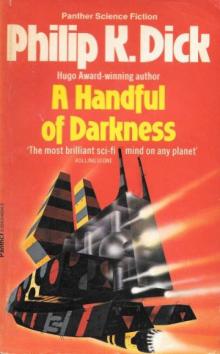 A Handful of Darkness
A Handful of Darkness Complete Stories 3 - Second Variety and Other Stories
Complete Stories 3 - Second Variety and Other Stories The Book of Philip K Dick
The Book of Philip K Dick The Transmigration of Timothy Archer (Valis)
The Transmigration of Timothy Archer (Valis) Autofac
Autofac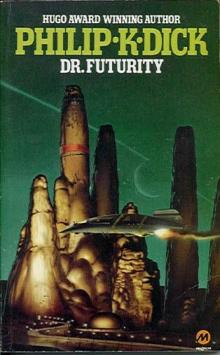 Dr. Futurity (1960)
Dr. Futurity (1960)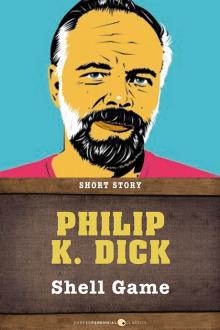 Shell Game
Shell Game The Minority Report and Other Classic Stories
The Minority Report and Other Classic Stories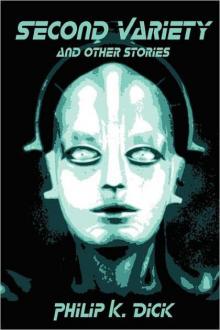 Collected Stories 2 - Second Variety and Other Classic Stories
Collected Stories 2 - Second Variety and Other Classic Stories The Third Time Travel
The Third Time Travel The Game-Players Of Titan
The Game-Players Of Titan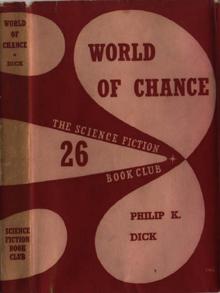 World of Chance
World of Chance The Shifting Realities of PK Dick
The Shifting Realities of PK Dick Adjustment Team
Adjustment Team The Demon at Agi Bridge and Other Japanese Tales (Translations from the Asian Classics)
The Demon at Agi Bridge and Other Japanese Tales (Translations from the Asian Classics)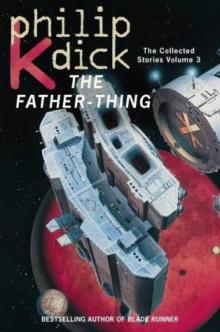 Collected Stories 3 - The Father-Thing and Other Classic Stories
Collected Stories 3 - The Father-Thing and Other Classic Stories CANTATA-141
CANTATA-141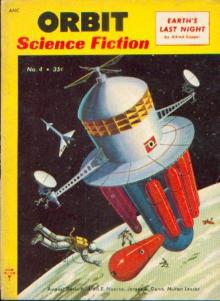 The Adjustment Team
The Adjustment Team The Collected Stories of Philip K Dick
The Collected Stories of Philip K Dick Electric Dreams
Electric Dreams Collected Stories 1 - The Short Happy Life of the Brown Oxford and Other Classic Stories
Collected Stories 1 - The Short Happy Life of the Brown Oxford and Other Classic Stories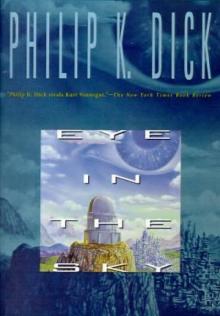 Eye in the Sky (1957)
Eye in the Sky (1957) In Milton Lumky Territory (1984)
In Milton Lumky Territory (1984) The VALIS Trilogy
The VALIS Trilogy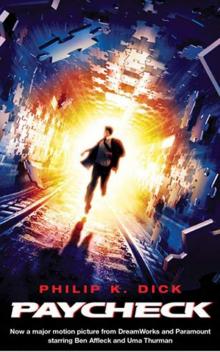 Paycheck (2003)
Paycheck (2003) The Unteleported Man
The Unteleported Man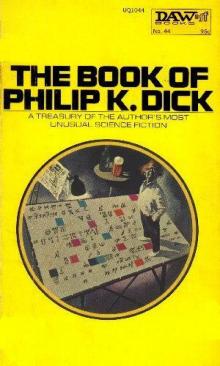 The Book of Philip K Dick (1973)
The Book of Philip K Dick (1973) Collected Stories 5 - The Eye of the Sibyl and Other Classic Strories
Collected Stories 5 - The Eye of the Sibyl and Other Classic Strories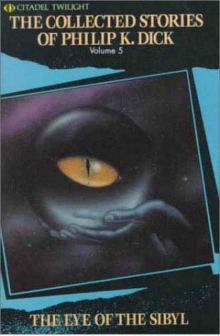 The Eye of the Sibyl and Other Classic Strories
The Eye of the Sibyl and Other Classic Strories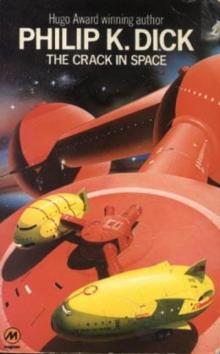 The Crack in Space (1966)
The Crack in Space (1966)